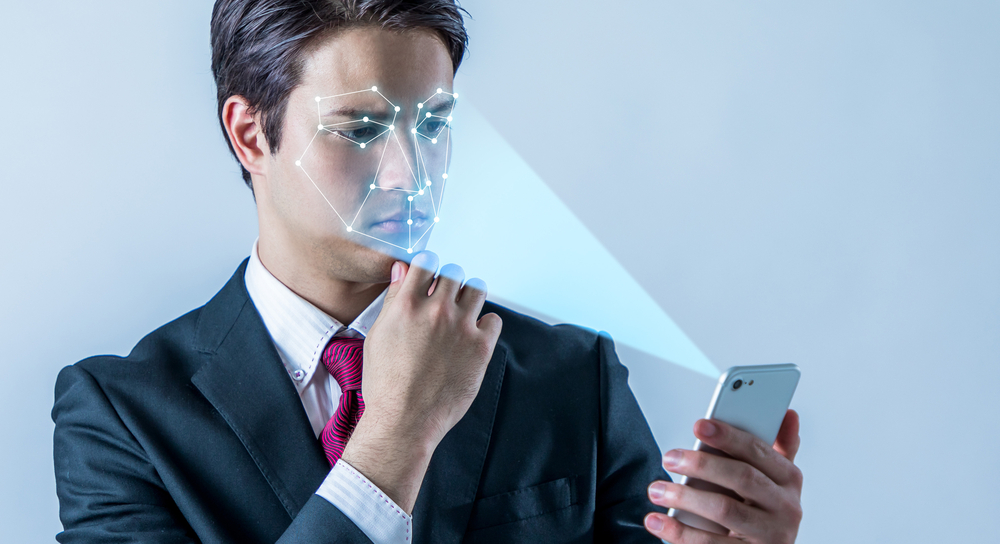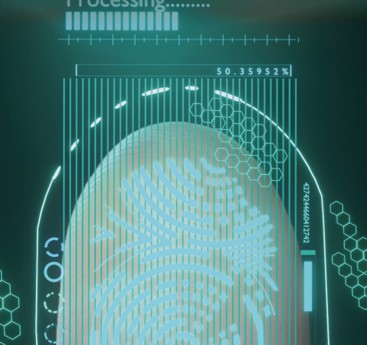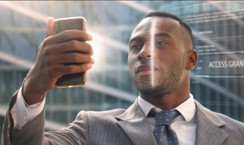
Think about the following questions.
1. Do you know of anyone who has been a victim of identity theft? What happened?
2. How safe do you feel in public places? Do you ever worry about terrorism?
3. What are some pros and cons of using parts of the body as identification?
VOCABULARY PREVIEW
Match each New Academic Word List(NAWL) word with the correct definition.
- morphology
- identification _____
- transaction _____
- marker _____
- replacement _____
- problematic _____
- a. the action of recognizing something or someone
- b. physical characteristics
- c. a symbol or sign representative of a category
- d. an exchange, usually of funds, goods, or services
- e. difficult; controversial
- f. one that takes the place of another
USING THE BODY FOR IDENTIFICATION

Technological advances have undoubtedly changed the way we engage in commerce and travel, as well as the way we live our lives. The internet allows us to shop from locations all over the globe without ever showing our faces or even talking to another person. We can buy and sell stocks online and move enormous amounts of money from one bank account to another at the click of a mouse. And international travel is increasingly common, with people crossing borders and oceans on a regular basis.
In short, the world is more accessible than it has ever been, but at a cost. How secure are our online transactions? With so many people crossing borders every day, how do we know we're not letting dangerous people into our countries? Improving security is a top issue for many governments and consumer advocacy groups around the world. One response is biometric-identification technology. This approach is being developed to recognize individuals, both to protect their own interests and to identify criminals.
Biometric identification is not a new invention. Law enforcement agencies have been using photographs and fingerprints as biometric identifiers since the late 19th century. But both can also be used for security. A fingerprint scanner, for instance, can be used to grant personnel1 access to certain areas or individuals access to their own digital devices. Physiological biometrics, such as fingerprints and facial features, use human morphology to identify or recognize individuals. In addition to fingerprint scanners, there are software programs that identify faces, palms, and irises2. Scanning these physical features ensures that the person being scanned is who he or she claims to be. Unlike a personal identification number, which is used to access bank accounts, it is extremely difficult, if not impossible, for criminals to steal biometric identifiers.
Behavioral biometrics can also be used to identify people. Certain behaviors are unique to individuals, such as their voices or the way they type. The classic behavioral biometric marker is a person's signature3. Signatures are used as a guarantee but can be problematic. They can be copied, for one thing. Also, people don't usually scrutinize4 a signature until a problem is apparent. However, people automatically recognize subtleties5 in the way others speak, such as intonation6 and accent, making imitation difficult. Typing patterns, likewise, are very difficult to mimic7 convincingly.
Biometrics has two potential applications: identification and identity verification8. Identification uses biometric information to discover the identity of an unknown person. Here, DNA evidence has joined fingerprints as a common tool of law enforcement. Identity verification is the process of making sure a person is who he or she claims to be. Today, we use passports to verify our identity when crossing borders. However, passports can be stolen or forged. But an effective biometric-identification system would be difficult to fool. Because of this, many countries are considering biometric additions to or replacements of existing identification systems. India, for instance, has already enacted such a system. It uses fingerprint and iris scans in addition to photographs. Using face recognition to verify travelers' identities is increasingly popular as well. The US has such systems in place in its busiest international airports.
However, there are ethical problems in developing biometric-identification technology. Some critics worry about the possibility of criminal uses of the technology. In theory, if a legitimate organization can use biometric scanners to verify personal information, criminals might be able to use the same technology to steal that information. And civil liberties advocates raise concerns about the potential for abuse by authorities. Therefore, policymakers will need to balance security and law enforcement against personal freedom and privacy.
New Academic Word List
- personnel 1 : n. the people who work at a particular place
- iris 2 : n. the colorful portion of the eye surrounding the pupil
- signature 3 : n. a mark representing a person's name, as written by that person
- scrutinize 4 : v. to look at closely
- subtlety 5 : n. a small detail that is usually important but is not obvious
- intonation 6 : n. the rise and fall in the sound of your voice as you speak
- mimic 7 : v. to imitate
- verification 8 : n. the act of making sure something is true
READING COMPREHENSION
A ‣ Mark each statement as true (T) or false (F) according to the reading.
- Biometric identification began with the invention of computers.
- True
- False
- Physiological biometrics can identify people by how they type.
- True
- False
- It is difficult to perfectly imitate the way a person speaks.
- True
- False
- Biometric identification is increasingly used in travel.
- True
- False
- Unless you are a criminal, there is little need to be concerned about biometrics.
- True
- False
B ‣ Choose the best answer according to the reading.
- What is the reading mainly about?
- a. The ethical problems with biometric identification
- b. The uses and challenges of biometric identification
- c. The history of biometric identification in law enforcement
- d. The difference between physiological and behavioral biometrics
- Which of the following is NOT scanned for identification?
- a. Faces
- b. Brains
- c. Palms
- d. Irises
- We can guess from paragraph 5 that _____.
- a. a higher number of fugitives try to enter India than elsewhere
- b. DNA will replace fingerprints as the main form of identification
- c. individuals often try to cross borders using fake identification
- d. the number of international criminals is on the rise
- The word forged in paragraph 5 means _____.
- a. faked
- b. missed
- c. shaped
- d. built
C ‣ Fill in the blanks with information from the reading.
- Fingerprints have been used since the late _____ .
- People are sensitive to _____ and _____ when they hear others speak.
- Besides photos, India's identification system uses _____ and _____ .
SUMMARY
An introductory sentence for a brief summary of the passage is given below. Choose three more sentences to complete the summary.
First Sentence: Biometric-identification devices, such as fingerprint scanners, can help maintain security in our high-tech world.
-
- 1 The two main uses are identity verification and the identification of unknown persons.
- 2 Police have used fingerprints and photographs as a basic technique to identify criminals for over a hundred years.
- 3 Voice-recognition systems scrutinize a person's voice and speech patterns, which contain subtleties that are difficult to mimic.
- 4 Biometric identification includes both physiological identifiers like fingerprints and behavioral identifiers like signatures.
- 5 Critics are concerned that biometric identification could jeopardize financial information and privacy.
- 6 Nowadays, people can move their money around and travel internationally with great ease.
VOCABULARY PRACTICE
Fill in the blanks with the words in the box. Change the form if necessary.
- identification
- marker
- morphology
- problematic
- replacement
- transaction
- Many apps have been developed that will allow people to use their mobile phones for _____ .
- Biologists compare the _____ of different species to help establish evolutionary links.
- When following a budget, it is important to keep track of even small _____ .
- These days, 3D printers can be useful when there is no available _____ for an old machine part.
- The study was _____ because the authors had a clear conflict of interest.
- The ability to read at an age-appropriate level is an important _____ of academic achievement.
SUPPLEMENTAL READING
Face-Recognition Technology

We generally recognize people by their faces or photos, which are typically unique to individuals. However, this type of identification can be faulty. People's appearances change, different people sometimes look quite similar, and we do not tend to scrutinize photos very closely. Today, biometric technology is being developed to perfect the process of facial identification.
Face-recognition technology can scan the face for certain features and measure the distances between different parts of the face. These things do not change, so growing a beard or wearing glasses will not fool the scanner. Since it is impossible to mimic another person's underlying skull structure, this type of identification is quite reliable. For that reason, and because of its convenience, people now routinely use face recognition to unlock their phones.
But face recognition presents a privacy risk. Face scanners might be placed in public places, for instance, and used without the public's knowledge. This raises concerns about how that information might be used and creates uneasiness about the surveillance of innocent people.
Privacy issues notwithstanding, the technology could improve security. For example, cameras can be used to monitor crowds at venues like airports, sports stadiums, festivals, or shopping centers, secretly capturing images of individuals. These images can then be compared to photos of known terrorists. This might help law enforcement identify and neutralize certain terrorist threats. But accuracy-specifically false positives-remains an issue in large crowds. Developers will likely need to improve accuracy to gain public acceptance.
Fill in the blanks with information from the reading.
- One problem with photo identification is that sometimes different people look _____ .
- Although superficial things like facial hair may change, a person's underlying _____ remains the same.
- Cameras that monitor large crowds could help catch _____ .

Leave a comment
Load more